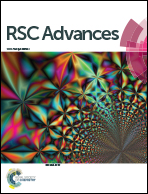Dioxin sensing properties of graphene and hexagonal boron nitride based van der Waals solids: a first-principles study†
Abstract
The changes in the electronic properties of single and bilayers of graphene (G) and hexagonal boron nitride (h-BN) two dimensional (2D) sheets have been investigated upon interaction with 2,3,7,8-tetrachlorodibenzo-p-dioxin (TCDD) by employing density functional theory (DFT) based calculations. The calculated interaction energy, band gap and charge transfer reveal that bilayer h-BN (BLBN) may serve as a better potential candidate for sensing TCDD than the other systems. To gain further insight into the sensing properties of these materials, the transmission spectra and current–voltage (I–V) characteristics have been calculated by using Non-Equilibrium Green's Function (NEGF) combined with DFT approach. It is interesting to mention that a Negative Differential Resistance (NDR) effect has been observed in a single layer BN (SLBN) nanoribbon upon interaction with TCDD. The calculated I–V characteristics of the BLBN nanoribbon–TCDD complex reveal that the interaction between the two systems enhances the current flow through the BLBN nanoribbon, which is appreciably higher than that of pristine BLBN. These findings may open up new avenues for the application of bilayers as possible sensors for pollutants.


 Please wait while we load your content...
Please wait while we load your content...